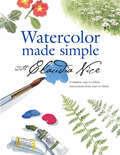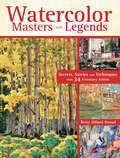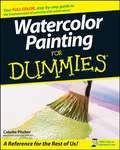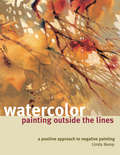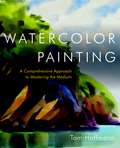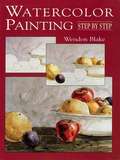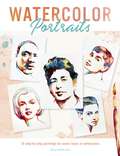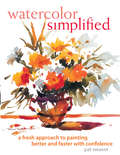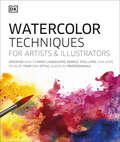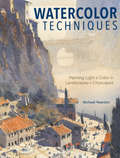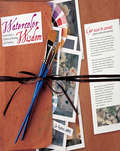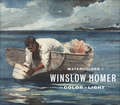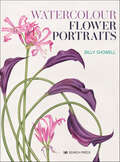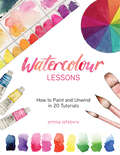- Table View
- List View
Watercolor Made Simple with Claudia Nice
by Claudia NiceExpand your artistic horizons with watercolor!Watercolor is a fun, challenging medium that captures the magic of light and color. Now world-renowned artist and instructor Claudia Nice helps you get started in watercolor today.In Watercolor Made Simple with Claudia Nice, you'll start with the very basics, learning new techniques as you paint. Detailed instructions and step-by-step artwork show you how to:Explore the amazing variety of effects you can get by painting watercolors on dry, damp or wet paperMix paint and water to create a variety of soft, beautiful washesUse fun and easy techniques such as spatter, sponging and stamping to bring a lively new look to your workBlend colors on your palette to capture the precise shade you're seekingUse your brushes, papers and paints to produce wonderful textural effectsThroughout, you'll find helpful troubleshooting tips, practical exercises, and Claudia's encouraging advice - all so you, too, can become a watercolor pro.
Watercolor Masters and Legends: Secrets, Stories and Techniques from 34 Visionary Artists
by Betsy Dillard StroudDiscover the secrets of watercolor mastery! Late 20th and 21st century watercolor artists have transformed the art of watermedia into a golden phenomenon and one of the most significant movements in the history of art. The lives and works of the 34 artists represented here display a multitude of different approaches, philosophies and techniques. Each has a unique perspective and an innovative approach; artists such as Ann Smith, Cheng-Kee Chee, John Salminen and many more share their secrets. You'll also get a behind-the-scenes look at legends like Robert E. Wood, Naomi Brotherton, Edgar A. Whitney and Ed Betts, whose teaching and work contributes invaluably to the aesthetics of the medium and their students.More than 125 pieces of exquisite art18 innovative demonstrations34 artist interviews and commentariesDiscover proud watercolor painting traditions, new perspectives on the medium, and works of art to influence new generations of artists. Get ready to be inspired with this one of a kind collection.
Watercolor Painting For Dummies
by Colette PitcherHave you ever been amazed by watercolor paintings that seem to spring to life before your eyes? Would you love to be able to paint with watercolors? Now, you can. Watercolor Painting For Dummies shows you the fun and easy way to create breathtaking paintings so beautiful you won't believe you made them yourself.This friendly, guide gives you hands-on instruction and easy-to-follow, step-by-step exercises to help you master the basics. Filled with full-color projects and sample paintings, it shows you how to work with color and texture, practice composition, and make smooth changes. You'll find out how to select the best tools, materials, and supplies, practice basic brush strokes, and use the three best common techniques: flat wash, graded wash, and rough texture. Discover how to:Select the right brushes, pigments, and paperMix colors and work with whiteCreate backgrounds and foregroundsTransfer your drawings to watercolorAvoid common watercolor mistakesExperiment with texture using salt, sponges, plastic wrap, and moreFind your way around the color wheelPractice the principles of designPlan compositions using thumbnailsWork with one-point, two-point, and three-point perspectivePaint fabrics, shiny surfaces, and organic texturesPaint landscapes, seascapes, animals and moreComplete with strategies for improving your painting immediately and marketing and selling your work, Watercolor Painting For Dummies, is the resource you need to make your creative dreams come true.
Watercolor Painting Outside the Lines
by Linda KempHarness the power of negative space!Breathe new life into your art through negative painting. Linda Kemp shares her techniques for using the strength of negative space - the areas not occupied by subject matter - to create alluring works of art.Watercolor Painting Outside the Lines is a comprehensive guide to evoking more passion in your paintings. You'll learn how to take hold of the often-overlooked areas of a painting through interactive, easy to follow elements including:Step-by-step techniques, exercises and projectsDo-it-yourself tests and worksheetsTroubleshooting suggestions and secretsStraightforward diagrams for color and designBoth beginning and advanced artists will benefit from negative painting concepts presented in this guide. Using landscapes, florals, and motifs from nature, you'll gain the skills and knowledge to make your next watercolor your most striking work yet.
Watercolor Painting Step by Step
by Barbara Fudurich Marilyn Grame Geri Medway Lori SimonsTools, materials, tips and techniques of watercolor painting.
Watercolor Painting: A Comprehensive Approach to Mastering the Medium
by Tom HoffmannThe beauty of a watercolor painting lies in its diaphanous layers, delicate strokes, and luminous washes. However, the very features that define the beauty of the medium can make it difficult to master. This complete guide to understanding the relationships between color, value, wetness, and composition unravels the mysteries of watercolor to help your practice evolve. Experienced teacher and acclaimed artist Tom Hoffmann offers a unique, inquiry-based approach that shows you how to translate any subject into the language of watercolor. With Hoffmann as your guide, you'll learn the key questions to ask yourself at every turn and time-tested methods to help you reach solutions. Hoffmann's thorough explanations and step-by-step demonstrations delineate the process of composing a painting in watercolor, while art from more than thirty-five past and present masters, including John Singer Sargent, Ogden Pleissner, George Post, Emil Kosa, Jr., Mary Whyte, Trevor Chamberlain, Lars Lerin, Torgeir Schjølberg, Piet Lap, Leslie Frontz, and Alvaro Castagnet serve to illustrate and inspire. Whether you're a serious beginner or a seasoned practitioner, this book will guide you toward the all-important balance between restraint and risk-taking that every watercolorist seeks. From the Hardcover edition.
Watercolor Painting: Step by Step
by Wendon BlakeArtists at every level can develop and refine their skills and talents with this clear, concise introduction to watercolor painting, by a noted artist and teacher.Brimming with practical suggestions and useful tips, this easy-to-follow guide opens with an overview of tools and equipment (e.g., needed brushes, paints, and paper) as well as work area and palette layout and other basics of organization. The author proceeds to discussions of fundamental wash and drybrush techniques. Then, using a series of eight "demonstrations" to show various stages of eight works in progress, he explains the essential techniques of watercolor paintings. Watercolorists will learn how to model in color; how to paint fruit, flowers, rocks, and trees; and how to render a variety of still life, landscape, and seascape scenes. In addition to a section on special effects, readers receive expert advice on scratching wet and dry color, sponging out, scrubbing out, cleaning up, preserving watercolors, and other relevant topics.Clearly written and beautifully illustrated, this book is an invaluable resource for anyone wishing to master this compelling medium.
Watercolor Pencil, Step By Step
by Pat Averill Barbara Benedetti Newton Debra K. YaunProvides tips and techniques of how to draw by using watercolor pencils, in a step-by-step guide.
Watercolor Portraits: 15 step-by-step paintings for iconic faces in watercolors
by Nelli AndrejewPainting expressive portraits of iconic faces has never been easier with this unique approach to watercolor painting. In this fresh and super-accessible approach to modern portraiture, artist Nelli Andrejew removes any barriers to painting instantly recognizable faces. In just a few simple brushstrokes you can capture the essence and likeness of 15 international icons and create modern watercolor portraits you will be proud to hang on the wall. The 15 famous personalities included have all made a valuable contribution to the world in some way - be it science, art or human rights. The subtle style of the portraits you'll learn how to paint in this book bring these heroes to life in watercolor, with step-by-step instructions and practical templates for tracing, removing the need for any real skill ; just trace, paint, have fun, and paint portraits that will surprise and delight all who see them. With this book you will learn how to paint: Leonardo DiCaprio , Virginia Woolf , James Dean , Lana Del Rey , Bob Dylan , Michelle Obama , Albert Einstein , Marilyn Monroe , Girl with a Pearl Earring , Martin Luther King Jr. , Audrey Hepburn , Mona Lisa , Coco Chanel , Emma Watson , Vincent Van Gogh In addition to the step-by-step tutorials, Nelli shares her tips and experience in the basic techniques you will need, from how to transfer the templates to your watercolour paper, to different ways to work with watercolors to successful portraits. This beautiful guide will inspire you to try all the faces included and then go on to paint your own original portraits with the same techniques. The perfect way to spend a creative afternoon!
Watercolor Simplified: A Fresh Approach To Painting Better And Faster With Confidence
by Pat WeaverDiscover how fresh and spontaneous watercolor can be!In Watercolor Simplified, Pat Weaver details the fundamental principles of good painting that will enable you to work faster and looser with more confidence. She shows you how to build a solid foundation then create fresh, beautiful work quickly. You'll learn how to:Master the principles of good compositionSelect the best color palette for your subjectPrepare, sketch, then execute your designPaint with joyful spontaneityWeaver also provides nine step-by-step demonstrations, covering a range of subjects, from animals and people to flowers and buildings. In no time at all, you'll begin experiencing greater confidence and creativity every time you pick up a brush.
Watercolor Techniques for Artists and Illustrators: Learn How to Paint Landscapes, People, Still Lifes, and More.
by DKThe only instructional book on watercolor you will ever need.Trying your hand at watercolor painting? Or looking to advance your range of artistic skills?Watercolor Techniques for Artists and Illustrators is for you.Beginning with the basics - such as honing your observational skills, choosing a subject, and learning about composition - the book then takes a comprehensive, in-depth look at techniques to expand your repertoire.With expert advice from artists and illustrators working in a range of styles - from classic to cutting-edge contemporary -this book will equip you with the skills and confidence to develop your own style and grow as an artist.
Watercolor Techniques: Painting Light and Color in Landscapes and Cityscapes
by Michael Reardon"No other medium is as magical and enjoyable as watercolor." So says artist and author Michael Reardon. In Watercolor Techniques: Painting Light and Color in Landscapes and Cityscapes, Reardon covers it all, from answers to beginners' most vexing problems (What is the proper ratio of pigment and water? How do I lay down an even wash? Why do my paintings look so washed out?) to understanding the trifecta of perspective, value, and color. He shows how to paint whites that sparkle and shadows that glow and how to conjure the atmosphere of a particular place and time. Painters of all skill levels will see--and feel--the difference in their work.Packed with expert advice for infusing scenes with light and colorIncludes special tips and techniques for painting architectural subjectsIllustrated with inspiring paintings of scenes from around the world8 start-to-finish demonstrations show key concepts in action"Light, as it glances off a facade, glimmers off the water or gleams off polished marble, is always inspiring. Color, with its infinite array of hues, is always irresistible. Searching for ways to make them harmonize and tell a story can last a lifetime."
Watercolor Tricks & Techniques: 75 New and Classic Painting Secrets
by Cathy JohnsonAdd life, color, texture and individuality to your work! If you're ready to go beyond the basics, and see what watercolor can really do, this is the book for you! Inside, a wealth of "creative departures" will take you out of your comfort zone, making the difference between pigment on paper and original, expressive works of art. Updated and better than ever, this edition of Watercolor Tricks & Techniques features: 30+ new watercolor materials and applications along with fresh insights on many tried-and-true techniques 15 step-by-step demonstrations showing techniques in action for beautiful finished paintings 3 possibility-packed sections–Liquid Aids, Dry Helpers and Indispensable Tools–exploring the possibilities of powdered pigments, granulating mediums, liquid mask, Yupo paper and much more Whether you're an advanced beginner ready to add a little zing to your repertoire or a seasoned painter looking to push your watercolor boundaries, this book will make the journey as exciting as the final destination.
Watercolor Unleashed: New Directions for Traditional Painting Techniques
by Julie Gilbert PollardDiscover fresh, forgiving techniques that promise less frustration and juicier results! Julie Gilbert Pollard subscribes to the "whatever works" school of painting. Not bound by tradition, she shows you how to unleash your watercolors for exciting and expressive results...and have lots of fun doing it! See how a few simple steps at the beginning can preserve the lights, lock in the darks, and allow you greater freedom to let your watercolor do what it does best: move and flow wet-into-wet, creating luminous layers of depth and vitality. Inside you'll find: 9 step-by-step painting demonstrations, plus many more quick lessons illustrating basic techniques. How to paint water, rocks, trees and other landscape elements in a lively manner. Easy techniques for making your paintings pop, including tips for successful spattering. How to combine a representational painting style with abstract acrylic underpaintings for unique and lively results. This book is all about painting boldly, embracing the medium's unpredictable nature, and achieving a loose, painterly quality. It's ideal for the beginner trying to get off on the right foot, as well as the intermediate artist looking for ways to "freshen up" their approach.
Watercolor Wisdom: Painting Techniques, Tips And Exercises
by Jo TaylorWatercolor Wisdom is an essential reference for every watercolor artist. It shares the knowledge, insights, tips and tricks that author Jo Taylor has accumulated over 30 years of painting and teaching, delivering a complete watercolor course that provides all the answers any painter will ever need for good painting. With the friendly tone of a gentle and seasoned teacher, Jo Taylor illustrates each lesson with large examples, stimulating exercises, visual comparisons and diagrams that are as engaging as they are effective. Beginning chapters focus on the basics of strong painting, including color, texture, value, composition and technique. The last chapter challenges readers to develop their design abilities and experiment with new artistic techniques, drawing upon the elements and principles learned to reinforce the lessons of this comprehensive guide. Throughout, readers will find big, beautiful art that teaches as well as inspires.
Watercolor and Acrylic Painting Materials
by William F. PowellProvides tips and techniques on how to paint with watercolor acrylics and how to use painting materials.
Watercolor for the Absolute Beginner: A Clear And Easy Guide To Successful Painting (Art for the Absolute Beginner)
by Mary Willenbrink Mark Willenbrink WrittenCovering topics as materials, value, color and composition, this highly visual guide shows absolute beginners how to express their creative sides through painting.
Watercolor for the Soul: Simple Painting Projects for Beginners, to Calm, Soothe and Inspire
by Sharone StevensLearn how to use watercolor to soothe your soul with this beginner's guide to painting for relaxation. This fresh approach looks first at the process of painting as a means to de-stress and unwind. Many people love the idea of painting but hold themselves back from starting because they are worried about not being good enough or not feeling as though as are creative. In this guide for the absolute beginner, artist and teacher Sharone Stevens shows you that watercolor can be accessible to everyone and that just painting very simple lines, patterns and shapes in calming colors, concentrating on each brush stroke, can have a powerful meditative effect, while at the same time allowing you to create beautiful art you can be proud of. She also encourages you to connect more with the world around you, finding inspiration in your every-day life and discovering the beautiful textures found in nature, from tree trunks to fruit and butterflies! The aim of the techniques and projects in this book is to create art that relaxes both the artist and the viewer of the finished piece. Projects range from simple gift tags, bookmarks, cards and small wall pieces to larger art pieces that you never thought possible ; all done with a focus on relaxation ; which is so important in today's fast-paced, increasingly digital world. Learn how to mix a calming color palette, try simple painting exercises to get into a relaxed flow, and create beautiful artworks that will lift the spirits both during the painting process and beyond, as finished pieces of art. Author Sharone Stevens is an established art teacher and talented artist who is passionate about using art for relaxation and encouraging others to build a regular creative practice. Her gentle lessons and nurturing reassurance will guide even total beginners through the process of making soothing, soulful modern watercolor art.
Watercolor in Bloom: Painting the Spring and Summer Garden
by Mary BackerPainting pretty, prized flowers is easier than you think!Using an uncomplicated palette and simple techniques, Mary Backer shares the secrets behind her prize-winning watercolor flowers. From first strokes to final touches, you'll learn everything you need to know to paint brilliant orange poppies, plump peonies, graceful lotus blossoms, classic roses and other garden favorites.Features:an exciting variety of flowers and compositions, from individual flower studies to more elaborate, mixed arrangements12 full-length demonstrations take you from first sketch to final brushstrokeIllustrates step-by-step watercolor techniques for achieving luscious color, complementary backgrounds and dramatic, up-close compositionsPlus a unique acrylic finishing technique that makes colors really popExperienced and novice artists alike will revel in the inspiration and easy-to-follow instruction inside. Watercolor in Bloom makes painting flowers as pleasurable as a stroll through the garden!
Watercolor: From Concept to Finished Painting (Dover Art Instruction)
by Tony CouchA complete watercolor instruction guide, this long-time bestseller is full of vibrant illustrations, examples of what to do and what to avoid, and tips that make the medium accessible. Written by a true master, it presents practical information on the basics of setting up a good painting — composition, color, and light — before discussing the medium's advantages and concluding with informative demonstrations.Tony Couch emphasizes practice as the key to developing watercolor skills. Starting with equipment choices and methods for controlling paint on wet paper, he proceeds to discussions and illustrations of the elements and principles of design. Other topics include working with color and value, pulling together a composition, and acquiring techniques for handling watercolor. Easy-to-follow examples chart the progress from a rough sketch into a finished painting. Watercolor: You Can Do It! is an ideal companion for beginning to advanced artists, suitable for individual study as well as a text for art students and teachers.
Watercolor: Paint Cute Animals and Wildlife in 12 Easy Lessons
by Natalia SkatulaLearn how to paint adorable animals, flavorful fruits, lively plants, and more in this free-and-easy approach to watercolor. Artist Natalia Skatula has a beautiful, whimsical style that will charm you through twelve simple step-by-step projects and over one hundred worked examples. Beginning with an overview of materials and equipment, Natalia then covers the general techniques needed to achieve the paintings, along with her top-ten personal tips for success. Projects include: A majestic whale An adorable sloth Elephants Pandas Dogs Llamas Bears Foxes Rabbits And more Watercolor Wild and Free also includes a range of presentation ideas to inspire you to put your finished work on display or gift it. The gallery of examples that follows includes plants, cats, beetles, birds, sealife, jungle creatures and fruits, giving you a treasure-trove of references for your painting. This book also makes the perfect gift for artists of all ages, especially plant and animal lovers. Find the inspiration and technique to start your watercoloring adventures with this beautiful guide!
Watercolor: Realistic Painting (How to Draw & Paint)
by Daniel K. TennantLearn to create paintings of remarkable realism and vividness with this concise guide from a prize-winning artist.Creating a piece of artwork that might be mistaken for a photograph is the goal of many aspiring artists. With this thirty-two-page guide, even beginners can learn methods for painting with amazing realism and accuracy. Accomplished artist Daniel Tennant explains the basics of using gouache and airbrushing and provides in-depth information on essential techniques such as gradating, using stencils, and creating a metallic effect. He also offers instruction on common elements of traditional still lifes, guiding readers from applying the initial layer of color through adding texture to detailing with shadows and highlights. The book also features several inspiring projects, each broken down into numerous digestible steps so artists can easily follow along.
Watercolors by Winslow Homer
by Martha TedeschiAmerican painter Winslow Homer (1836-1910) created some of the most breathtaking and influential watercolors in the history of the medium. This handsome volume provides a comprehensive look at Homer's technical and artistic practice as a watercolorist, and at the experiences that shaped his remarkable development. Focusing on 25 rarely seen watercolors from the Art Institute's collection, along with 75 other related watercolors, gouaches, drawings, and paintings--including many of the artist's characteristic subjects--the book proposes a new understanding of Homer's techniques as they evolved over his career. Accessibly written essays consider each of the featured works in detail, examining the relationship between monochrome drawing and watercolor and the artist's lifelong interest in new optical and color theories. In particular, they show how his sojourn in England--where he encountered leading British marine watercolorists and the dynamic avant-garde art scene--precipitated an abrupt change in technique and subject matter upon his return home. Conservators address the fragility of these watercolors, which are prone to fading due to light exposure, and demonstrate, through pioneering research on Homer's pigments and computer-assisted imaging, how the works have changed over time. Several of Homer's greatest watercolors are digitally "restored," providing an exhilarating glimpse of the original impact of Homer's groundbreaking color experiments.Â
Watercolour Flower Portraits
by Billy Showell"The book is packed with step-by-step guides on drawing and painting techniques, colour mixing and clever compositions, it is an invaluable source of ideas for anyone wanting to develop their flower painting skills." – SAABilly Showell's exquisite and technically brilliant watercolour flower portraits are beautifully presented in this highly informative, lavishly illustrated book. First published in 2009 and now back by popular demand in paperback, it provides the reader with valuable information on the brushes, paints, paper and other equipment they need, together with detailed guidance on drawing and painting techniques, colour mixing and composition. Learn how to paint white flowers, leaves and stems; add shadows; and create stamen, carpels, veins and texture. The book finishes with four stunning step-by-step projects to practice and consolidate your newly-acquired skills. This is an invaluable source of information and inspiration for anyone who wants to develop their flower painting skills.
Watercolour Lessons: How to Paint and Unwind in 20 Tutorials
by Emma LefebvreA Watercolour How-To Book for the Whimsical Creative"I am brand new to watercolor and this book is exactly what I needed. Highly recommended." —Amazon review#1 Bestseller in Watercolor Painting, Plants & Animals, Mixed Media & DecoratingTake a walk down the path of translucent pastels and delicate wet washes with Watercolour Lessons. Filled with engaging exercises, this vibrant guide contains step-by-step instructions on how to paint with watercolours. For beginners and those looking to improve their technique, Watercolour Lessons brings artistic inspiration to any home.A watercolour guide book that is uniquely you. Follow author and artist Emma Lefebvre as she teaches the fundamentals of this simple-to-use painting medium. With an emphasis on developing skills and style, Watercolour Lessons offers the necessary tools to produce paintings anyone would be proud to display, gift, or to keep for themselves.Learn how to paint with watercolours. For beginners and mavens alike, Watercolour Lessons offers straight-forward lessons to help anyone develop their craft and unique artistic style. From color theory to tool sets, it explores watercolour basics while helping painters—old and new—gain confidence in themselves and their work.Inside, you’ll find:A list of essential watercolour tools and how to use themAn easy-to-understand explanation of watercolour techniques and theoriesCharmingly simple watercolor painting projects with step-by-step instructionsNotes on common mistakes and how to fix themIf you’re looking for creative art therapy exercises, want to learn how to paint with watercolors for beginners or intermediate artists, or enjoy books such as Watercolor the Easy Way Flowers, Watercolor Workbook, Watercolor With Me in the Forest, or Everyday Watercolor, you’ll love Watercolour Lessons.
